
You may be stumped as to why you’re not ranking well (or at all)…but don’t say it’s because you tried everything and just couldn’t figure it out.
You probably didn’t try everything.
I can think of 56 diagnostics you should try if you want to troubleshoot local SEO problems or find missed opportunities. I’ll tell you all 56 in a minute.
First, a few points about what this post is not:
It’s not a list of every tool. That’s what this post is for.
It’s not a technical audit (although a few of my suggestions fall into that category).
It’s not a tutorial on exactly what to do about what each diagnostic may show you. Many times the next steps will be clear, but sometimes they’re tricky. (For maximum detail on action items, get my free guide – or consider my X-Ray service.)
By the way, this is an evergreen post, so I’ll keep adding diagnostics. (Please leave a comment if you have any to suggest.)
Let’s get into it, shall we? I’ve broken this up into 7 sections. You can click on a link to jump to a section.
…or you can just start right here at the top.
General diagnostics
Measure the business’s distance to the center of town
Look up driving directions (in Google Maps) from the business to the town where it’s located or where its owners want to rank. Are you 20 miles from what Google considers the center of town? Are you significantly farther away than your higher-ranking competitors are? You want a sense of whether it’s even possible to rank in your “target” city.
Search in the business’s ZIP code
Type a search term into Google, click the “Search tools” button under the search bar, and enter the ZIP or postal code that the business is located in. Does it rank?
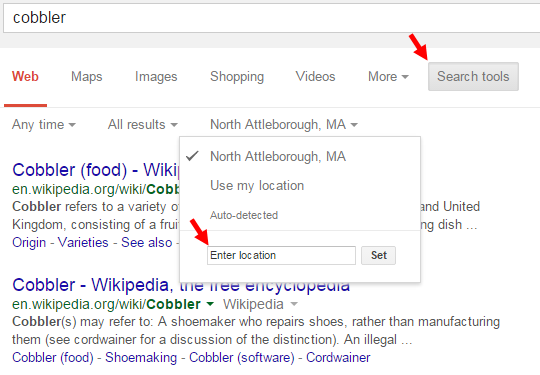
Search in an incognito browser window
You may see biased results if you’re logged into your Google account or if you haven’t cleared your browser’s cookies in a while.
Study Google Analytics
For now, just log in and look for any steep dips in traffic. Then you can use these other diagnostics to figure out why the drop-off happened. (There are tons of resources for learning about Google Analytics in-depth, and they’re easy to find, so I’ll leave that part to you.)
Check Google Webmaster Tools
Any crawl or indexation issues?
Check your Apple Maps, Bing Places, and Yahoo Local rankings
If you rank more visibly in those places than in Google, it’s less likely you’re looking at a technical issue on your website and more likely that you’re staring at Google’s sharp fangs.
Get my questionnaire filled out
I’m talkin’ about this. Probably only useful if you’re the SEO person who needs all the pertinent facts from your client – although it might still be a useful exercise even if you’re doing your own local SEO.
Google Places diagnostics
Check for the Google Places pack
Are you seeing only organic results for search terms that used to pull up the Google Places 7-pack (or 3-pack) results – or vice versa?
Perform a brand-name search
Do you see the Google Places page? Is it the correct one? Do you see the expected listings on other sites (e.g. Yelp)?
Search from different default locations
Type in a search term, click the “Search tools” button under the search bar, and enter other cities or ZIP codes.
Check rankings both with and without city names
Do you rank for “dentist” but not for “Cleveland dentist”?
Check the “Maps” tab
Are you ranked #10? Are you on page 5? To find out, type in a search term, click the “Map results…” link under the Google Places results, then click the “See results in list view” link. That’s for checking your visibility in the “new” Google Maps. But, as Linda points out, you should also check your rankings in classic Maps, because you may see different results there – possibly pre-Pigeon-update results.
Search on Google Plus
Go to plus.google.com, sign in, go to the “Local” tab, and search for the business. Can you find its Google Places page? Is it the one you expected to find?
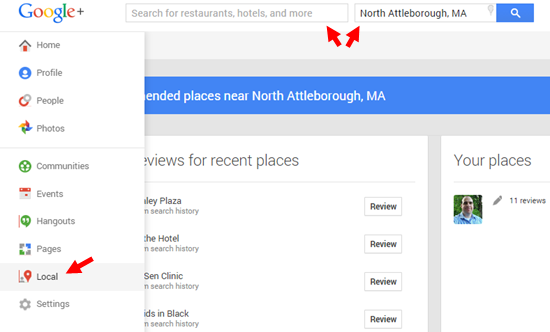
Check both Googles
Let’s say your business is in Canada. Check its rankings both on Google.com and on Google.ca. You may notice a huge difference.
Make sure the page is verified
Look for the little checkmark near the profile photo.

Make sure the page has been “upgraded”
Do you see only an “About” and “Photos” tab, or do you see 3-4 tabs (like “Posts,” “Videos,” or “YouTube”)?
See if Google has made changes without your OK
Yes, Google does that sometimes. Log into your Google My Business dashboard and you may see a message that says Google made tweaks to your page (usually to your address or categories).
![]()
Search for your business in MapMaker
Look at the “Details” tab. Is any info incorrect? (By the way, don’t bother with this step if you’ve got a service-area business.) If anything seems incorrect, don’t mess around with it without reading this post first.
Check your map-marker location
Google your address. Now check out on the map on your Google Places page. Does the red marker show up in exactly the same place on the map? If not, move the marker.
Find duplicate or near-duplicate Google Places pages
Use Michael Cottam’s excellent and free tool. Or use the old-school techniques that Joy Hawkins’ describes.
Check the Google Places landing page URL
Go to your Places page and click the link to your site. Does it forward to a domain other than the one you just clicked on? Does it even take you to your website at all (yes, I’ve seen typos here, sad to say)? Please tell me you’re using your homepage as the landing page.
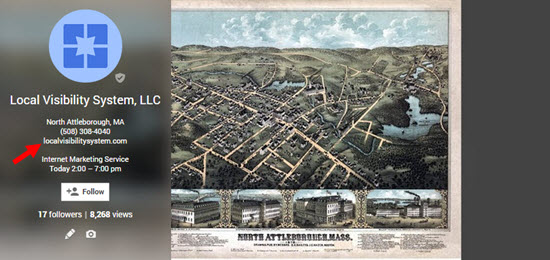
Double-check the business hours
I’ve seen significant traffic dips on (for example) weekends when I’ve had clients who are closed on weekends. Is that because search volume is naturally lower on the weekend because people are taking it easy, and that’s why the businesses are closed to begin with? Or is Google less likely to show search results that contain closed businesses? I suspect it’s a little of both. So make sure your hours don’t mark you as “Closed” for more hours than you really are closed.
Website diagnostics
Do a site:yourwebsite.com search
How many of your pages are indexed? Are you seeing old, duplicate versions of pages? Are all your title tags the same (or just terrible)?
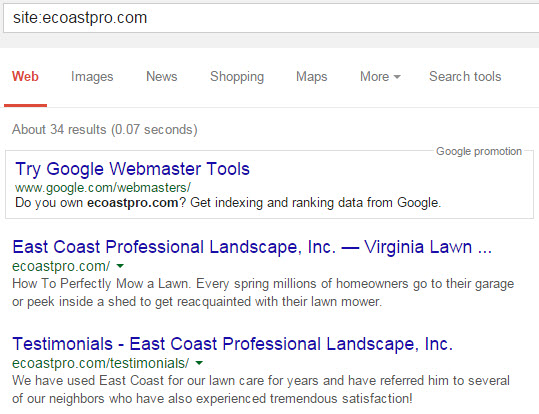
Check your robots.txt
Go to yourwebsite.com/robots.txt. Make sure it doesn’t contain the dreaded “Disallow: /” line. Especially if you’re not sure how to assess a robots.txt file you’ll want to use Google’s tester.
Look for mirror sites
I’m talking about clones of the site you want to rank well: same guts, different domain name. Slimy companies may build these for you in a misguided attempt to try to “track conversions.” The best way to find them is to Google a few lines of text from your homepage, and to see whether another domain pops up in Google. Or use Copyscape or Plagium.
Find any unwanted subdomains or staging sites
Search for them by typing site:yourwebsite.com -www search. Hat tip to the Local SEO Guide guys for reminding me about this one.
Make sure the NAP info is crawlable text
Google needs to be able to read your name / address / phone (“NAP”) info. That’s not possible if your NAP is an image. So here’s the test: can you copy and paste it? If so, Google can read it OK.
View the source code
Only do this if you are your own webmaster, have built websites in the past, or otherwise know what to look for. But if you do know what to look for, you may find some real demons.
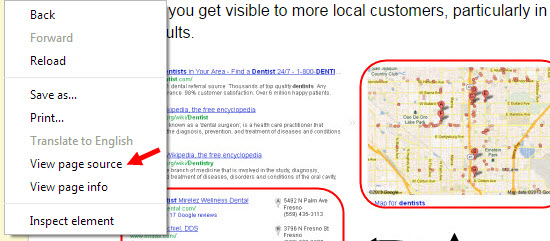
Check the site on a smartphone
If you’re in an industry where a lot of the traffic (let’s say 30% or more) is from smartphones and you don’t have a mobile-friendly site, your bounce rate may be high. That may hurt your rankings.
Use Google’s Mobile-Friendly Test tool
Hat tip to Tony of Cartography Marketing for reminding me of this one.
Check the “itemtype” line in your Schema.org markup
The itemty-…huh? I explain that one in another long post. It’s a little technical, and it won’t explain low rankings, but it might give you a slight edge in the local roller-derby.
Citation diagnostics
Do a (free) Moz Local scan
Hands-down the best way to get a quick sense of how much work your citations need. Oh, and don’t ignore the suggestions for categories.
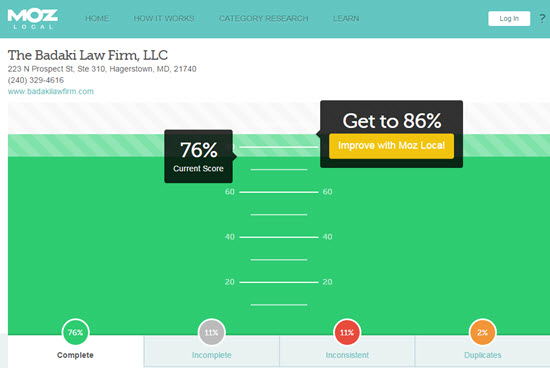
Check the BBB record
I love this hack. You can find alternative business names, old phone numbers, and more.
Make sure you’re listed on Google’s pets
Beyond Yelp and YP, what sites rank well for the terms you’re trying to rank for? For instance, Google expects you to be on HealthGrades if you’re a doctor, or Avvo if you’re a lawyer, or Houzz if you’re a contractor. I’m mostly talking about industry sites. Thanks to Gyi Tsakalakis for reminding me of this point.
Search for the phone number in the standard format
I like to search with dashes as the separators (e.g. 123-867-3509). It’ll pull up the same results as it would if you Googled the phone number with parentheses around the area code.
Search the phone number with periods as separators
Some people think the dots look chic, so they use them in their phone number. But Google does not treat periods the same as dashes. You may see different search results come up when you search for the number with periods (e.g. 123.867.5309).
Search for your business name and city
Great diagnostic from Darren: “If everything is in order, you should see a knowledge panel for the business. If you don’t get one, that can indicate Google isn’t getting enough signals to identify your brand. Try working on citation audit & cleanup, and review acquisition.” (By the way, Darren’s crew can help with messy citations.)
Search for the address
What kind of address is it (e.g. residential)? Do the expected business listings (e.g. YellowPages) come up? Do you see unexpected phone numbers come up? Any discrepancies as to what city / town that address might be in?
Do a USPS ZIP Lookup
What town does Uncle Sam think your ZIP is in? Know that before you touch your citations.
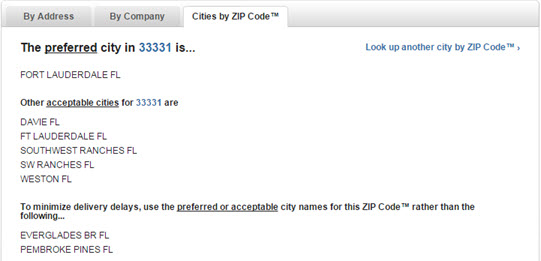
Use the Local Citation Finder
Do your competitors have better local citations? Which competitors? Where can you go to get those citations? The Local Citation Finder can save you hours of toiling.
Use NAP Hunter
Those madmen at Local SEO Guide created a Chrome extension to help you unearth incorrect and duplicate citations. Another huge time-saver. Or, if you want to take the scenic route, you can use the sitelinks search box to find duplicate citations.
Yext free scan
Ignore the eschatological “144 Errors!” warnings and just get a rough sense of how many totally wrong phone numbers, addresses, and names are floating around the web, and on what sites. Note: if you use Yext’s free scan you’ll get solicited by Yext. (Thanks to Rob Scutti for reminding me of this trade-off.)
Check the state’s Secretary of State filing
Fix any business info that’s incorrect or out-of-date.
Check THE big YellowPages-type player in your country
YellowPages.ca is the make-or-break listing if you’re in Canada. YellowPages.com.au is huge you’re in Australia. Yell.com is crucial if you’re in the UK. Get your listing right and you may see progress on the Google Places side.
Check Twitter for acknowledged problems
Great resource: Bill Bean’s Twitter Handles for Local Business Citation Sources.
Link diagnostics
Check backlinks
Use OpenSiteExplorer, MajesticSEO, or Ahrefs – or some combination of the three, ideally. Spot-check your links and decide if they’re junk. Get any junk links removed.
Check Google Webmaster Tools for a manual penalty
A worst-case scenario (one reason you don’t want to skip the “Check backlinks” step).
Get a Toxic Links score from LinkDelete
Another one in Darren’s words: “Run their quick scan to get a sense of how many bad links you have. Don’t freak out if the number is higher than expected. They tend to over-report a bit, in my opinion.”
Look at the release history of Penguin and other algorithm updates
Does Google Analytics show a steep drop-off in traffic on or right after a day that Google released an algorithm update?
Check for links between affiliated businesses
Do your five sites merrily link to each other? Don’t.
Review diagnostics
Type in [name of business] + reviews
Just see what – if anything – comes up. Not having many or any reviews is bad local SEO and worse marketing. Read this and this.
Check Google’s reviews dashboard
Sometimes buggy and won’t pick up Yelp reviews, but good for getting a quick sense of where a business has reviews.

Check YellowBot
Same goal as above. As I’ve shown, reviews from all over the place show up on YellowBot.
Check the “More reviews” section in the knowledge graph
Yet another way to check for where a business has reviews.
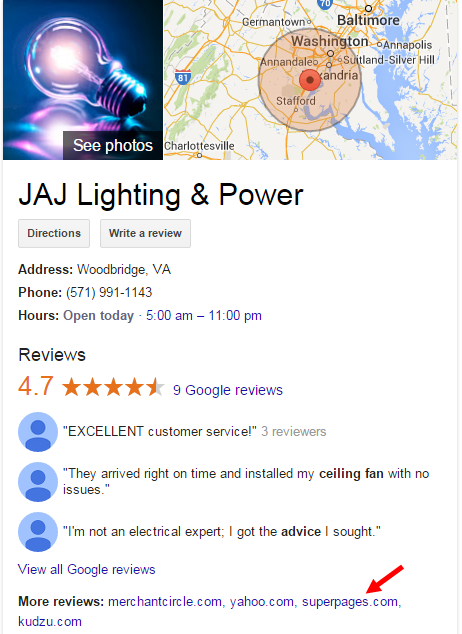
Find filtered Google+ reviews
See this brilliant post by Joy Hawkins.
My 7-point quick checkup:
I can uncover probably 80% of problems in about 10 minutes, just by doing these quick tests (which I mentioned earlier):
1. Check rankings both with and without city names
2. Perform a brand-name search
3. Measure the business’s distance to the center of town
4. Do a site:yourwebsite.com search
5. Do a (free) Moz Local scan
6. Google the phone number(s)
7. Check backlinks
Great further reading
Advanced Local Citation Audit & Clean Up: Achieve Consistent Data & Higher Rankings
– Casey Meraz
Troubleshooting Local Ranking Failures: a Beginner’s Guide
– Miriam Ellis
*Local SEO Audit Template
– Dan Leibson
(*That’s not the real title of the post, but I’m not shoehorning that 17-word monstrosity in here. Sorry, Dan 🙂 Nice post, though.)
—
Do you have a problem you still can’t figure out after trying those diagnostics?
Is there a troubleshooting method I forgot?
What’s your favorite?
Leave a comment!
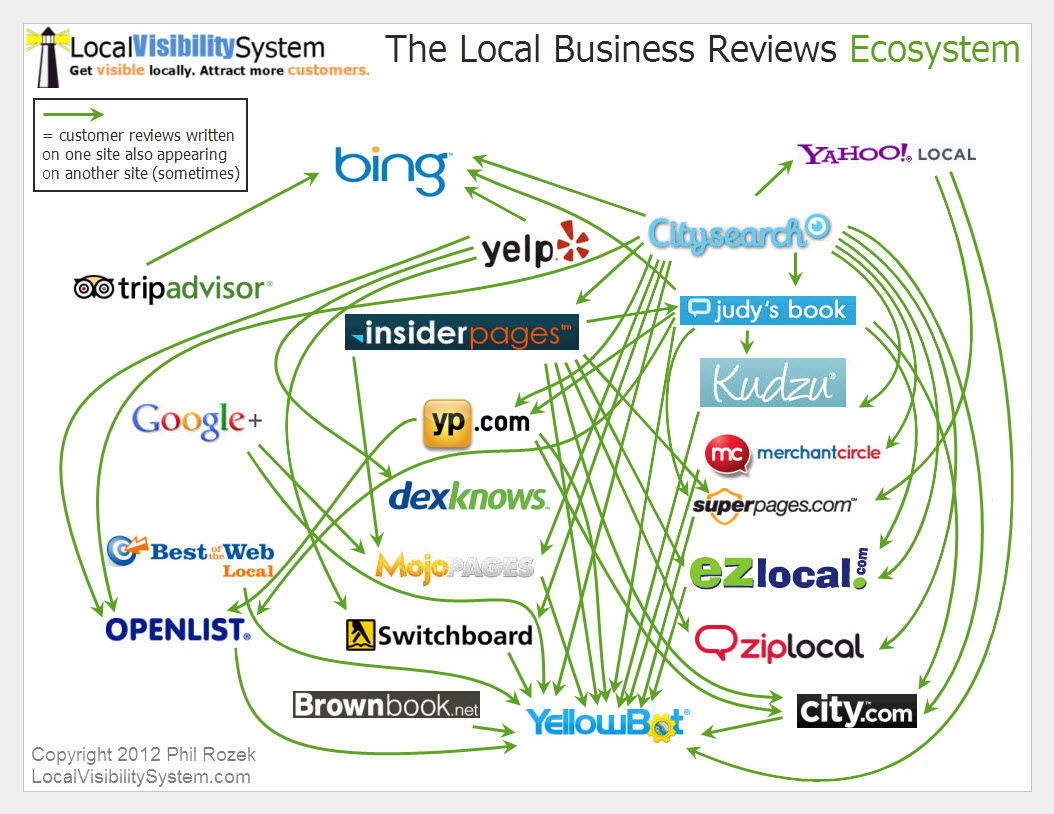
 Local Google is a minefield of bugs, glitches, often-murky “
Local Google is a minefield of bugs, glitches, often-murky “